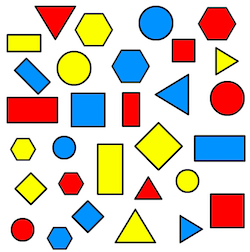Copyright © University of Cambridge. All rights reserved.
'Sorting Logic Blocks' printed from https://nrich.maths.org/
Show menu
Why do this activity?
This activity can be used to build up children's confidence with the language associated with 2D shape.
Possible approach
You can do this activity as a whole class, teacher-led activity, by creating shapes on the interactive whiteboard. Choose a particular property and drag a shape which meets that criteria to the left of the screen underneath a title of something like 'These shapes are in my set', or simply 'Yes'. (Alternatively, you could print off, laminate and cut out shapes from this sheet and stick them to the board.)
The first time you do this it's a good idea to conduct it in silence. Children take turns to come to the front and select a shape. Without saying anything, you drag it to the appropriate side of the screen. When they think they know your rule they could write it down on their whiteboards.
Once they become familiar with the game, you can interrogate them about their choices. 'Why did you choose that one?'; 'I'll put that one here - what does that tell you?'.
You could then give out sets of the shapes to pairs of children for them to try themselves (if you have 'logiblocks' these are ideal, otherwise print off shapes from the sheet). In this way, you can use the same activity to highlight different properties of shapes so it can be returned to many times over the course of an academic year.
Key questions
Why did you choose that one?
I'll put that one here - what does that tell you?
Which would be a good one to choose now? Why?
Possible support
For a class that is less confident, you could scaffold their learning by writing several different rules on the board. They then know that your rule is one of those and can choose accordingly. Children could make up their own rule for you to write.
Possible extension
Challenge children to use as few shapes as possible to test their ideas.
 For this task, you'll need some blocks of different shapes and colours, or you could print off and cut out the shapes on
For this task, you'll need some blocks of different shapes and colours, or you could print off and cut out the shapes on